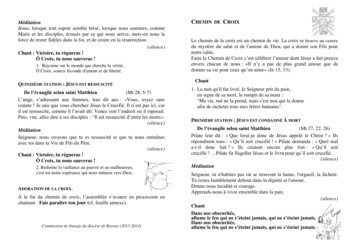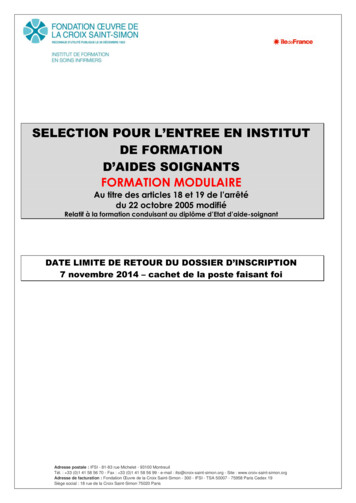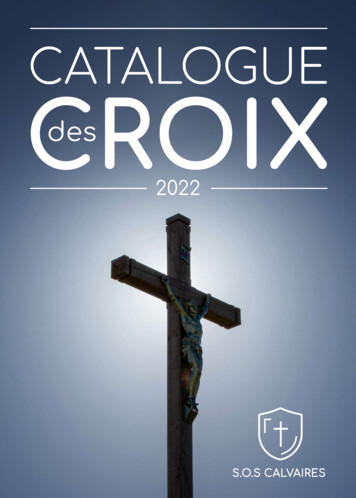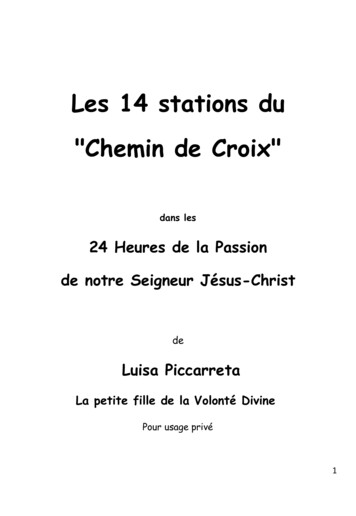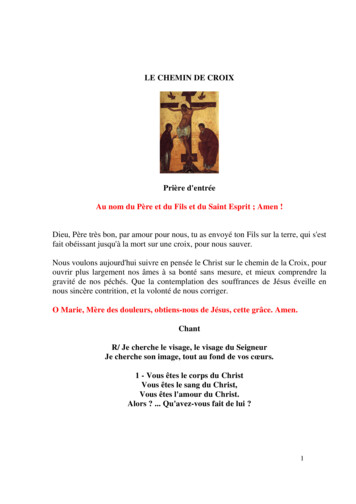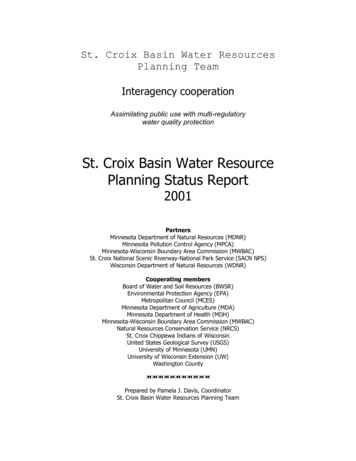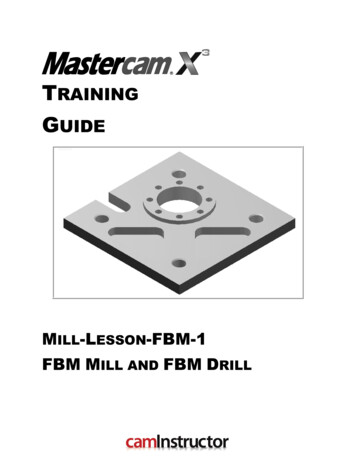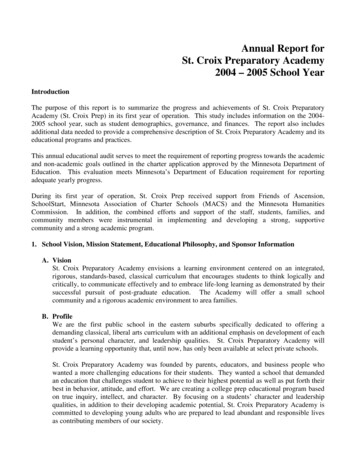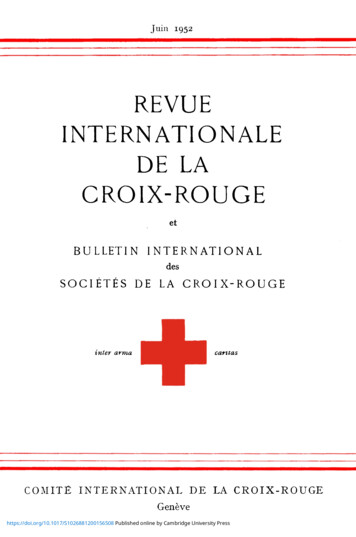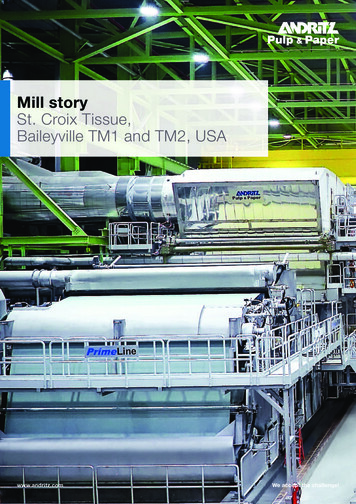
Transcription
Mill storySt. Croix Tissue,Baileyville TM1 and TM2, USAwww.andritz.comWe accept the challenge!
Gathering impressionsBaileyville, Washington County,MaineBaileyville is a small town located in Washington County, Maine,and was originally settled by Quakers in 1780.contentsGathering impressions02St. Croix Tissue04The strong newcomer inthe US tissue businessHigh-capacity twins06Two tissue machines with2,000 m/min speedHappy producers, happy10convertersExcellent product qualityPrime production of tissuewith innovative technology11The St. Croix River forms part of the Canada–United States borderbetween Maine (USA) and New Brunswick (Canada). Flickr.The St. Croix Valley is rich in water. The Baileyville aquifer can produce 3,000 gallons/minuteof clean, fresh water. Downeast Economic DevelopmentMaine and Washington Countyeasternmost point of land in the continentalfrom the Atlantic coast. Ocean shipsThe St. Croix ValleyThe state of Maine was originally part of theUnited States, which is West Quoddy Headcould navigate upstream to Calais and St.The region around the St. Croix River isCommonwealth of Massachusetts. Mainein Quoddy Head State Park, Lubec, Maine.Stephen. In time, the tidal fluctuation maderich in agriculture. The main focus lies onvoted to secede from Massachusetts toThe famous red and white striped WestEastport a preferred port for deeper draftberries and hard cider production to createbecome the 23rd state on March 15, 1820.Quoddy Head lighthouse sits here over-vessels. The river upstream of Calais andvalue-added products for the region.Washington County is located in the north-looking the Quoddy Narrows. The QuoddySt. Stephen became an important trans-eastern part of Maine and it is also partNarrows is the strait between Lubec, Maineportation corridor for log driving to bringFrom Woodland to Baileyvilleof the “Downeast” region. The “Downeast”and Campobello Island, Canada, and pro-logs for lumber and pulpwood from the in-Woodland was originally the name of theterm originally came from sailors describingvides access to Passamaquoddy Bay andterior forests to the saw mills and paperentire town of Baileyville until the 1990s.Baileyvillethe direction of the prevailing winds thatto harbors located on the St. Croix River.mills built to use water power at Calais andBesides Woodland of Washington County,Baileyville is a small and growing town thatpushed sailing ships “downwind” and toCampobello Island is a small CanadianWoodland.there was also Woodland of Aroostockoffers a relaxed way of life surrounded bythe “east” as they carried their cargo upIsland in the Bay of Fundy that was theCounty. According to the laws of Maine, twobeautiful nature that includes the near-the coast from Boston and other east coastsummer home of President Franklin D.towns are not allowed to share the sameby Moosehorn National Wildlife Refuge.ports to this part of Maine. The “Downeast”Roosevelt and his family for over 50 years.name. Because Woodland of AroostockBaileyville is also well positioned to supportterm later expanded to define this region’sThe Bay of Fundy has the highest tideCounty was founded as a township first, thebusinesses and industries with the St. Croixculture, which is based on its strong mari-swings in world, which measure a waterstate court allowed it to keep its name andRiver and nearby Eastport ME Seaport fortime background and influenced by thelevel height change over 18 feet (5.5 me-Woodland of Washington County was or-water transportation; being close to threerugged ocean coastline, small towns, ruralters) twice a day. The St. Croix River heightdered to choose a new name: “Baileyville”.main bridges going to Canada for truck-life, and harsh weather that can come andis impacted by this tidal fluctuation as muchWoodland is now just a census-designateding transportation; a local municipal airportgo in this part of upper Maine.as 15 miles inland from the sea.place in the town of Baileyville.that can handle small jets for air transporta-Washington County was named for GeorgeThe St. Croix RiverWashington. It is also known as theThe St. Croix River was an early trade cor-“Sunrise County” because it includes theridor to interior Maine and New BrunswickBaileyville ― key facts:Inhabitants: approx. 1,500Size: 41.91 sq mi (108.5 km2)Main industries:pulp and paper production,logistic servicestion; and having rail service to Canada that02The St. Croix Valley is rich in wild blueberries,cranberries, and pine. Tracey Webberis available in conjunction with St. CroixTissue and Woodland Pulp.03
Woodlandpulp millSt. Croix TissueThe strong newcomer in US tissue businessTwo decades ago, the Woodland mill in Maine was a vibrant pulp and papercomplex. Suffering the fate of many commodity pulp and fine paper mills,Woodland was near extinction in 2010 when a company with a vision boughtthe assets, injected USD 200 million (EUR 170 million), and changed the courseto value-added tissue production.St. Croix Tissue is among the newest pro-Grand Investment Corp. (IGIC), the par-ducers of premium tissue parent rolls inent company of Woodland Pulp, St. CroixNorth America. The machine hall is builtTissue, and Cascade Pacific Pulp mill innext to the existing hardwood pulp millHalsey, Oregon. “Just prior to our buyingWoodland Pulp. Mirror-image ANDRITZWoodland in 2010, the owner (Domtar) putPrimeLine tissue machines, which startedthe mill into indefinite shutdown.”up in 2016, are quickly ramping up to acombined design production of 126,000 t/a.“Without question, the addition of tissuemaking capabilities saved this pulp mill,”says Arvind K. Agarwal, CEO of InternationalThe affiliate company of St. Croix Tissue,Woodland Pulp, is located next to itThe future of this facility as acommodity pulp mill was simplynot sustainable.”along the St. Croix River. Both compa St. Croix’s Marconies together form the largest employerL’Italien, Vicein Washington County, with approximat-President (left) withMarty Richard,Arvind K. AgarwalCEO, International Grand Investment Corp.Tissue Managered 320 jobs. The mills were founded in1904 as St. Croix Paper Co. and beganoperating in Baileyville two years later.RebirthPremium pulpThe rebirth of the mill has special meaningaround by converting it from a commodityToday, the Woodland Pulp mill producesto Marty Richard, Tissue Manager. Richardproducer to a value-added facility.”St. Croix Hardwood, a premium Northernwas raised in the local community andECF bleached Kraft pulp manufacturedworked at the mill for 16 years. “We sawAgarwal and his team went to work imme-using hardwood chips from Maine andsome tough times and it looked like thediately. “First thing,” Agarwal says, “wasNew Brunswick, Canada. The pulp is soldend was near,” Richard says. “In the lateto reduce our dependence on oil by bring-to paper makers all over the world and1980s, there were 1,200 people working ining natural gas to the mill. Local distribu-approximately one-third of the pulp isthe pulp, paper, and OSB (oriented strandtion companies said it would take severalused by St. Croix Tissue.board) plants around here.years to permit and build a pipeline. We didit in 10 months with an investment of USDGreen productionBefore IGIC came in there were about 32017 million. That was a positive indicatorWoodland pulp has a strong historypeople in the pulp mill left. To come fullto the employees and community that weof environment stewardship. Over thecircle where we are investing and hiring –meant business.”years, it has reduced its environmen-for a mill that has a bright future – is reallyrewarding to be part of.”tal footprint and continues to support“There were also investments to improveresponsible forestry management tothe reliability and throughput of the kraftensure environmental sustainability forSetting the stagemill,” says Marco L’Italien, Vice President.generations to come. The owners have“When we acquired Woodland in 2010, weThese investments set the stage for the an-made significant capital investments inalready had the idea to maximize our returnnouncement in 2013 that a new tissue millenvironmental controls for air, waste-by adding tissue making capacity,” sayswould be built.water, and solid waste compliance.Agarwal. “My job was to turn this facilityWoodland pulp is 100% energy self-sufficient and has state-of-the-art air pollu St. Croix Tissue produces 88-inch (2,235 mm)tion control equipment.diameter rolls.0405
High-capacity twinsTwo tissue machines with 2,000 m/min speedProven supplierBuilding the visionAccording to Tom Dorsch, Project Leadermachine that would give us roll widthsThe contract with ANDRITZ was signed infor St. Croix, “We went through a very de-from the standard 102 inches (2,591 mm)January 2014. Groundbreaking for thetailed process to develop the specs for thisup to 112 inches (2,845 mm). Not toonew mill occurred in October 2014. “Wemill, and ANDRITZ was able to fulfill all themany tissue manufacturers have this ca-had one of Maine’s harshest winters,”requirements of our spec.”pability on-machine.”Dorsch recalls. “This at the time we weredoing the deep foundation work. ThereOf importance was a spec for a steel Yan-“We have come to appreciate ANDRITZ’swere challenges to be sure, but all of thekee, instead of cast iron, because of thecontribution not only for their up-frontsuppliers, including ANDRITZ, stepped upheat transfer advantages and safety fac-engineering, but also for their un-to help us recover schedule.”tors. St. Croix specified 18-foot diameterderstanding of the entire process,”Yankees instead of the standard 16-footAgarwal says. “They have been an ex-For the Baileyville area this was a massiveones. “The larger Yankees were a goodcellent partner the entire time – from theconstruction project. “Logistics was onechoice,” L’Italien says. “We don’t have nui-initial design to optimization of the mill.of our biggest challenges given our remotesance breaks since we have eliminated theThey have also kept in the forefront oflocation,” Dorsch says. “It is 35 miles to asteambox and simplified the machine.”technology, ahead of their competitors.”deep water port, 90 miles to the closestairport, and highway access is by two-laneAnother consideration was machine width.roads. We had over one million construc-“To meet the needs of one of our keytion hours involving 525 people on-site atcustomers,” Richard says, “we needed aour peak in the middle of winter.” Tom Dorsch, St. Croix Project Leader (left) with John Schamell, ANDRITZ’s Vice President North America forSuccessful start-upstissue and drying, on TM2.On the equipment side, ANDRITZ delivered the first machine in May and the second one in August 2015. “We began commissioning TM1 in January 2016,” saysJohn Schamell, ANDRITZ’s North American Vice President for tissue and drying.“Even though construction was proceeding around us, we checked the machineSt. Croix specified a large steel Yankee (18-foot diameter)for both machines. TM1 started up in March and TM2 in July 2016.out section by section. It was a little hecticand the operators were brand new. But,we got stock on the wire in early March.”ANDRITZ Yankee serviceANDRITZ offers comprehensive Yankeeperformance. The service range is suitableThe second machine was commissionedservice activities by focusing on the overallfor all types of Yankee, for tissue or paperand started up with a more traditional ap-added value of the Yankee: from the calcu-machines, MG paper or tobacco, steel orproach and pace. “It started up well,” sayslation to manufacturing and coating, opera-cast Yankees, old or new, regardless of theSchamell, “even though we had fewer re-tion, and optimization.OEM. The service package that ANDRITZoffers includes solutions and support forsources since TM1 was in full operationby then, we had a good start-up in JulySeeing the complete pictureupgrades and replacements, safety issues,2016.”The ANDRITZ Yankee service succeedsproduction, and analysis (e.g. on-the-runwith lasting effect in improving your ma-measurements).chine’s efficiency as well as your Yankee’s0607
PrimeLineTM W8High-speed tissue machines with 5.6 m width0809
Happy producers, happy convertersExcellent product qualityThe innovative technology concept of the two CrescentFormer tissuemachines and the local training program really pay off.“In our first full month of operation with bothmachines, we reached 70% of saleable design capacity for this mill,” Dorsch says. “Ithink that’s a pretty fast ramp-up.” Whenasked about the working relationship withANDRITZ, Dorsch comments, “Wheneverthere were issues, ANDRITZ took ownership. Any problem got fixed and got fixedwell. They were very open and transparent.They were always sensitive to timing, costs,and the impact on our operations. They arean excellent partner that way.”Multi-national machineAbout 85% of the machine componentswere manufactured at ANDRITZ’s facilityin Foshan, China. The steel Yankees wereOperators in the control room for TM1 and TM2.fabricated in ANDRITZ’s state-of-the-artworkshop in Hungary. Headbox, press rolls,and hydraulic systems came from Europeworkforce was green with very little tissueExcellent runability and smoothnessand the air systems came from Canada.experience.” St. Croix partnered with the“Every converter, who has run our tissue,“Like many North Americans, I wonderedlocal community college to design a train-likes it,” L’Italien says. “One converter waswhat the quality of the components manu-ing program so potential job candidatesable to raise speeds by 70% due to thefactured in China would be,” Richard says .could learn something about tissue making.runability of our product.” St. Croix con-“I went to the ANDRITZ workshop in FoshanCompleting the program did not guaranteesidered investing in structured tissue, butto inspect the first machine. It was cleara job, only the opportunity for an interview.decided to go with the CrescentFormer.that quality was the first thing on the minds“Then in August 2015 we hired the initial“Even though our tissue is not structured,of the people – we didn’t even have to askteam of 58 employees,” Richard says. “Theit is of very high quality,” Richard says. “Inthe question before management was ex-community college again partnered with ussome cases, it has allowed us to get a footplaining their QA/QC processes. It was im-for a four-month training program. Much ofin the door in traditional structured mar-pressive. After delivery, we could see thatthis training was conducted by suppliers,kets. The formation on the CrescentFormerthe workmanship was really excellent.”including ANDRITZ.” Part of the funding foris just so good that we can compete wellANDRITZ PULP & PAPER is an experiencedsumption form the basis of our offerings.process to reduce energy consumption.this project comes through a New Marketin the softness for the higher end bathand proven partner to the global tissue ma-PrimeLine tissue machines are available asThe PrimeDry steel Yankee (up to 22 ft.tax credit program.tissues.” “Before we started up, I waschine industry. Through continuous devel-PrimeLineCOMPACT, PrimeLineTM, anddiameter) is made entirely of steel, resultingconcerned about physical quality of theopment and project experience around thePrimeLineTAD tissue machines. Key com-in greater safety and higher performanceLocal training partnership“ANDRITZ committed a very good team toPrime production of tissuewith innovative technologyThere is increasing pressure for tissue producers to improve efficiencies and reduceconsumption of energy. ANDRITZ has solutions which are innovative, efficient, andminimize the consumption of resources – without compromising product quality.this project, and they integrated well withA requirement for that credit is that St. Croixreels, since we would be making 88-inchglobe, ANDRITZ offers world-class tissueponents of these tissue machines are idealdue to the elasticity of steel compared toour group,” Dorsch says. “This is the thirdhire 60% of its new employees from a low-(2,235 mm) diameter rolls,” L’Italien says.machinery and components with innova-for rebuilds and modernization projects.cast iron. The higher performance can bemachine-pair start-up I have worked onincome bracket and maintain that ratio forMy concerns were unfounded. These ma-tive features. Experience at productionand I can say that this project had moreseven years. “This has a huge benefit forchines make nice flat rolls with excellentspeeds exceeding 2,000 m/min, high-Reduced energy consumption is the key!more with steam, which is generally rela-vendor support than I have typically seen.the community,” L’Italien says.profiles. Whatever ANDRITZ is doing withquality paper grades, as well as advancedANDRITZ offers the EconoFit control con-tively cheap.its reel building technology certainly issolutions to reduce overall energy con-cept that monitors and analyzes the dryingBut, it was essential here given that ourused to save on energy costs by dryingworking.”1011
ContactAUSTRIAANDRITZ AGStattegger Strasse 188045 Graz, AustriaPhone: 43 (316) 6902 0UNITED STATESANDRITZ Paper Machinery Ltd.Janesville, USAPhone: 1 (608) 7585 930www.andritz.comAll data, information, statements, photographs and graphic illustrations in this leaflet are without any obligation and raise no liabilities to or form part of any sales contracts of ANDRITZ AGor any affiliates for equipment and/or systems referred to herein. ANDRITZ AG 2017. All rights reserved. No part of this copyrighted work may be reproduced, modified or distributed inany form or by any means, or stored in any database or retrieval system, without the prior written permission of ANDRITZ AG or its affiliates. Any such unauthorized use for any purposeis a violation of the relevant copyright laws. ANDRITZ AG, Stattegger Strasse 18, 8045 Graz, Austria.KPP.xs.01.eng.0117
Tom Dorsch, St. Croix Project Leader (left) with John Schamell, ANDRITZ's Vice President North America for tissue and drying, on TM2. Proven supplier According to Tom Dorsch, Project Leader for St. Croix, "We went through a very de-tailed process to develop the specs for this mill, and ANDRITZ was able to fulfill all the requirements of our spec." Of importance was a spec for a steel Yan .
